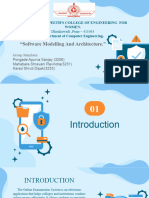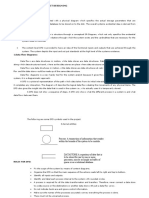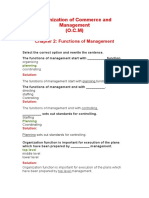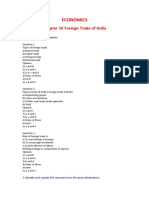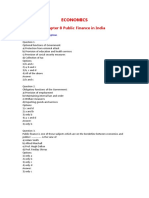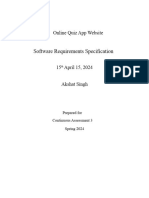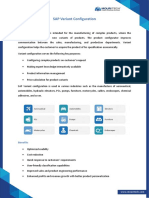Untitled 4
Uploaded by
Mehfooz PathanUntitled 4
Uploaded by
Mehfooz PathanProject Report - Online examination system
comp science (National Institute of Technology Agartala)
Scan to open on Studocu
Studocu is not sponsored or endorsed by any college or university
Downloaded by Hatechz ([email protected])
lOMoARcPSD|52452556
INDEX
SL. No CONTENTS
1. INTRODUCTION
2. ANALYSIS
2.1 SYSTEM ANALYSIS
2.2 SYSTEM SPECIFICATIONS
3. DESIGN APPROACH
3.1 INTRODUCTION TO DESIGN
3.2 UML DIAGRAMS
3.3 DATA FLOW DIAGRAMS
3.4 E-R DIAGRAMS
4. PROJECT MODULES
5. IMPLEMENTATION
5.1 CONCEPTS AND TECHNIQUES
5.2 TESTING
5.2.1 TEST CASES
6. OUTPUT SCREENS
7. CONCLUSIONS
8. FUTURE ENHANCEMENTS
9. BIBILIOGRAPHY
1. Existing System
System Specifications
INTRODUCTION:
Design is the first step in the development
phase for any techniques and principles for the purpose of defining a
device, a process or system in sufficient detail to permit its physical
realization.
Once the software requirements have
been analysed and specified the software design involves three
technical activities - design, coding, implementation and testing that
are required to build and verify the software.
The design activities are of main
importance in this phase, because in this activity, decisions
ultimately affecting the success of the software implementation and
its ease of maintenance are made. These decisions have the final
bearing upon reliability and maintainability of the system. Design is
the only way to accurately translate the customer’s requirements
into finished software or a system.
Design is the place where quality is
fostered in development. Software design is a process through
which requirements are translated into a representation of
software. Software design is conducted in two steps. Preliminary
design is concerned with the transformation of requirements into
data.
Downloaded by Hatechz ([email protected])
lOMoARcPSD|52452556
UML Diagrams:
Actor:
A coherent set of roles that users of use cases play when
interacting with the use `cases.
Use case:
A description of sequence of actions, including variants,
that a system performs that yields an observable result of value of
an actor.
UML stands for Unified Modelling Language. UML is a language for
specifying, visualizing and documenting the system. This is the step
while developing any product after analysis. The goal from this is to
produce a model of the entities involved in the project which later
need to be built. The representation of the entities that are to be
used in the product being developed need to be designed.
There are various kinds of methods in software design:
Downloaded by Hatechz ([email protected])
lOMoARcPSD|52452556
They are as follows:
Use case Diagram
Sequence Diagram
Collaboration Diagram
Activity Diagram
State chat Diagram
USECASE DIAGRAMS:
Use case diagrams model behaviour within a system and helps the
developers understand of what the user require. The stick man represents
what’s called an actor.
Use case diagram can be useful for getting an overall view of the
system and clarifying who can do and more importantly what they can’t do.
Use case diagram consists of use cases and actors and shows the
interaction between the use case and actors.
The purpose is to show the interactions between the use case and
actor.
To represent the system requirements from user’s perspective.
An actor could be the end-user of the system or an external system.
USECASE DIAGRAM:
A Use case is a description of set of sequence of actions. Graphically it
is rendered as an ellipse with solid line including only its name. Use case diagram
is a behavioral diagram that shows a set of use cases and actors and their
Downloaded by Hatechz ([email protected])
lOMoARcPSD|52452556
relationship. It is an association between the use cases and actors. An actor
represents a real-world object. Primary Actor – Sender, Secondary Actor
Receiver.
SEQUENCE DIAGRAM:
Sequence diagram and collaboration diagram are called
INTERACTION DIAGRAMS. An interaction diagram shows an interaction,
consisting of set of objects and their relationship including the messages that
may be dispatched among them.
A sequence diagram is an introduction that empathizes the
time ordering of messages. Graphically a sequence diagram is a table that shows
objects arranged along the X-axis and messages ordered in increasing time
along the Y-axis.
Downloaded by Hatechz ([email protected])
lOMoARcPSD|52452556
COLLABORATION DIAGRAM:
A collaboration diagram is an introduction diagram that emphasizes the
structural organization of the objects that send and receive messages.
Graphically a collaboration diagram is a collection of vertices and arcs.
Downloaded by Hatechz ([email protected])
lOMoARcPSD|52452556
CLASS DIAGRAM:
Class is nothing but a structure that contains both variables and methods.
The Class Diagram shows a set of classes, interfaces, and collaborations and
their relating ships. There is most common diagram in modeling the objectoriented systems and are
used to give the static view of a system. It shows the
dependency between the classes that can be used in our system.
The interactions between the modules or classes of our projects are
shown below. Each block contains Class Name, Variables and Methods.
CLASS:
A description of set of objects that share the same attributes, operations,
relationships, and semantics
Downloaded by Hatechz ([email protected])
lOMoARcPSD|52452556
State Chart Diagram
.
DATA FLOW DIAGRAMS :
The DFD takes an input-process-output view of a system i.e. data objects
flow into the software, are transformed by processing elements, and resultant
data objects flow out of the software.
Data objects represented by labelled arrows and transformation
are represented by circles also called as bubbles. DFD is presented in a
hierarchical fashion i.e., the first data flow model represents the system.
Downloaded by Hatechz ([email protected])
lOMoARcPSD|52452556
Subsequent DFD refine the context diagram (level 0 DFD), providing increasing
details with each subsequent level.
The DFD enables the software engineer to develop models of the
information domain & functional domain at the same time. As the DFD is refined
into greater levels of details, the analyst performs an implicit functional
decomposition of the system. At the same time, the DFD refinement results in a
corresponding refinement of the data as it moves through the process that
embody the applications.
A context-level DFD for the system the primary external
entities produce information for use by the system and consume information
generated by the system. The labelled arrow represents data objects or object
hierarchy.
RULES FOR DFD:
Fix the scope of the system by means of context diagrams.
Organize the DFD so that the main sequence of the actions
Reads left to right and top to bottom.
Identify all inputs and outputs.
Identify and label each process internal to the system with Rounded
circles.
A process is required for all the data transformation and Transfers.
Therefore, never connect a data store to a data Source or the
destinations or another data store with just a Data flow arrow.
Do not indicate hardware and ignore control information.
Make sure the names of the processes accurately convey everything
the process is done.
There must not be unnamed process.
Indicate external sources and destinations of the data, with
Squares.
Number each occurrence of repeated external entities.
Downloaded by Hatechz ([email protected])
lOMoARcPSD|52452556
Online Examina 琀椀 on
Database
Identify all data flows for each process step, except simple Record
retrievals.
Label data flow on each arrow.
Use details flow on each arrow.
Use the details flow arrow to indicate data movements.
DATAFLOW DIAGRAMS:
Database:
user registra 琀椀 on
User registra 琀椀 on
Take Test
User
registra 琀椀 on
User
details
Register
user
Update user
details Search for
user details
view user
details
Downloaded by Hatechz ([email protected])
lOMoARcPSD|52452556
Taking Test
Taking Test
E-R Diagrams:
The Entity-Relationship (ER) model was originally proposed by Peter in 1976
[Chen76] to unify the network and relational database views. Simply stated the ER
model is a conceptual data model that views the real world as entities and relationships.
A basic component of the model is the Entity-Relationship diagram which is used to
visually represents data objects. Since Chen wrote his paper the model has been
extended and today it is commonly used for database design For the database designer,
the utility of the ER model is:
it maps well to the relational model. The constructs used in the ER model can
easily be transformed into relational tables.
it is simple and easy to understand with a minimum of training. Therefore, the
model can be used by the database designer to communicate the design to the
end user.
In addition, the model can be used as a design plan by the database developer to
implement a data model in a specific database management software.
User
details
Start Exam End Exam View Result
Downloaded by Hatechz ([email protected])
lOMoARcPSD|52452556
ER Notation
There is no standard for representing data objects in ER diagrams. Each modeling
methodology uses its own notation. The original notation used by Chen is widely used in
academics texts and journals but rarely seen in either CASE tools or publications by
non-academics. Today, there are a number of notations used, among the more common
are Bachman, crow's foot, and IDEFIX.
All notational styles represent entities as rectangular boxes and relationships as
lines connecting boxes. Each style uses a special set of symbols to represent the
cardinality of a connection. The notation used in this document is from Martin. The
symbols used for the basic ER constructs are:
entities are represented by labelled rectangles. The label is the name of the
entity. Entity names should be singular nouns.
relationships are represented by a solid line connecting two entities. The name
of the relationship is written above the line. Relationship names should be verbs
attributes, when included, are listed inside the entity rectangle. Attributes
which are identifiers are underlined. Attribute names should be singular nouns.
cardinality of many is represented by a line ending in a crow's foot. If the
crow's foot is omitted, the cardinality is one.
existence is represented by placing a circle or a perpendicular bar on the line.
Mandatory existence is shown by the bar (looks like a 1) next to the entity for
an instance is required. Optional existence is shown by placing a circle next to
the entity that is optional.
Downloaded by Hatechz ([email protected])
lOMoARcPSD|52452556
Downloaded by Hatechz ([email protected])
lOMoARcPSD|52452556
MODULES
1: ADMIN MODULE
2.INSTRUCTOR MODULE
3.STUDENT MODULE
Downloaded by Hatechz ([email protected])
lOMoARcPSD|52452556
DATABASE TABLES:
USER REG TABLE
True/False Based Ques 琀椀 on Table
NAME NULL/NOTNULL TYPE KEY
ID NOTNULL INT PRIMARYKEY
QUE NULL VARCHAR(500)
AW NULL VARCHAR(500)
True/False Based Answer Table
NAME NULL/NOTNULL TYPE KEY
ID NOTNULL INT FOREIGNKEY
AW NULL VARCHAR(500)
NAME NULL/NOTNULL TYPE KEY
ID NOTNULL INT PRIMARYKEY
NAME NULL VARCHAR(50)
DOB NULL DATETIME
GENDER NULL VARCHAR(10)
BRANCH NULL VARCHAR(20)
CPFNO NULL VARCHAR(50)
UID NULL VARCHAR(50)
PWD NULL VARCHAR(20)
RPWD NULL VARCHAR(20)
UTYPE NULL VARCHAR(20)
QUE NULL VARCHAR(500)
ANS NULL VARCHAR(500)
Downloaded by Hatechz ([email protected])
lOMoARcPSD|52452556
Op 琀椀 ons Based Ques 琀椀 on Table
NAME NULL/NOTNULL TYPE KEY
QID NOTNULL INT PRIMARYKEY
QN NULL VARCHAR(500)
OPTIONS
1 NULL VARCHAR(100)
OPTIONS
2 NULL VARCHAR(100)
ANSWER NULL VARCHAR(100)
Op 琀椀 ons Based Answers
NAME NULL/NOTNULL TYPE KEY
QID NOTNULL INT FOREIGNKEY
ANSWER NULL VARCHAR(10)
All Student Marks
NAME NULL/NOTNULL TYPE KEY
ID NULL INT
MARKS NULL INT
Exam Schedule
NAME NULL/NOTNULL TYPE KEY
ENAME NULL VARCHAR(30)
EDATE NULL DATETIME
Downloaded by Hatechz ([email protected])
lOMoARcPSD|52452556
Downloaded by Hatechz ([email protected])
lOMoARcPSD|52452556
OUTPUT SCREENS
Downloaded by Hatechz ([email protected])
lOMoARcPSD|52452556
Downloaded by Hatechz ([email protected])
lOMoARcPSD|52452556
Downloaded by Hatechz ([email protected])
lOMoARcPSD|52452556
Downloaded by Hatechz ([email protected])
lOMoARcPSD|52452556
Downloaded by Hatechz ([email protected])
lOMoARcPSD|52452556
Downloaded by Hatechz ([email protected])
lOMoARcPSD|52452556
CONCLUSION
Downloaded by Hatechz ([email protected])
lOMoARcPSD|52452556
FUTURE ENHANCEMENTS
This application avoids the manual work and the problems
concern with it. It is an easy way to obtain the information regarding the
di 昀昀 erent scheduled examinations information that are
Currently issued.
Well, I and my team members have worked hard
in order to present an improved website better than the existing one’s
regarding the information about the various activities. Still, we found out
that the project can be done in a better way. Primarily, when we request
information about a particular schedule it just shows the exam date and
platform. So, after getting the information we can get access to the online
exam.
The enhancement that we can add the
searching option. We can directly search to the particular student details
from this site.
Downloaded by Hatechz ([email protected])
lOMoARcPSD|52452556
BIBLIOGRAPHY
Downloaded by Hatechz ([email protected])
lOMoARcPSD|52452556
You might also like
- Basic Software Modeling: ECE 417/617: Elements of Software Engineering Stan Birchfield Clemson UniversityNo ratings yetBasic Software Modeling: ECE 417/617: Elements of Software Engineering Stan Birchfield Clemson University29 pages
- L5 Unit 2 Requirement Analysis and DiagramsNo ratings yetL5 Unit 2 Requirement Analysis and Diagrams54 pages
- System Design: Unified Modeling LanguageNo ratings yetSystem Design: Unified Modeling Language15 pages
- Modeling: ECE 417/617: Elements of Software Engineering Stan Birchfield Clemson UniversityNo ratings yetModeling: ECE 417/617: Elements of Software Engineering Stan Birchfield Clemson University29 pages
- CSC 308 Object-Oriented Analysis and DesignNo ratings yetCSC 308 Object-Oriented Analysis and Design28 pages
- 01object Oriented System Design and AnalysisNo ratings yet01object Oriented System Design and Analysis46 pages
- Digital Notes: (Department of Computer Applications)100% (1)Digital Notes: (Department of Computer Applications)19 pages
- SRS, Uml, WBS: Class Diagram Activity Diagram Sequence Diagram Data Flow Diagram (DFD) ER DiagramNo ratings yetSRS, Uml, WBS: Class Diagram Activity Diagram Sequence Diagram Data Flow Diagram (DFD) ER Diagram30 pages
- LectureWeek06Final_6bbc2976-92ad-43ce-bb55-264366290401_109054_No ratings yetLectureWeek06Final_6bbc2976-92ad-43ce-bb55-264366290401_109054_25 pages
- Cs8582-Object Oriented Analysis and Design Laboratory-1532281778-Cs8582 - Ooad LabNo ratings yetCs8582-Object Oriented Analysis and Design Laboratory-1532281778-Cs8582 - Ooad Lab133 pages
- Software Design Description For: COMSATS University Islamabad, Sahiwal Campus - PakistanNo ratings yetSoftware Design Description For: COMSATS University Islamabad, Sahiwal Campus - Pakistan8 pages
- Java / J2EE Interview Questions You'll Most Likely Be AskedFrom EverandJava / J2EE Interview Questions You'll Most Likely Be AskedNo ratings yet
- THE SQL LANGUAGE: Master Database Management and Unlock the Power of Data (2024 Beginner's Guide)From EverandTHE SQL LANGUAGE: Master Database Management and Unlock the Power of Data (2024 Beginner's Guide)No ratings yet
- (OCM) Chapter 2 Functions of ManagementNo ratings yet(OCM) Chapter 2 Functions of Management35 pages
- (OCM) Chapter 1 Principles of ManagementNo ratings yet(OCM) Chapter 1 Principles of Management23 pages
- (ECO) Chapter 8 Public Finance in IndiaNo ratings yet(ECO) Chapter 8 Public Finance in India11 pages
- (ECO) Chapter 9 Money Market and Capital MarketNo ratings yet(ECO) Chapter 9 Money Market and Capital Market12 pages
- Oracle Train4sure 1z0-447 v2018-05-07 by Julia 42qNo ratings yetOracle Train4sure 1z0-447 v2018-05-07 by Julia 42q21 pages
- The Graphical Kernel System (GKS) : Daduceand FrahopgoodNo ratings yetThe Graphical Kernel System (GKS) : Daduceand Frahopgood14 pages
- Gmail - Booking Confirmation On IRCTC, Train - 12624, 28-Jan-2020, 3A, ERN - MASNo ratings yetGmail - Booking Confirmation On IRCTC, Train - 12624, 28-Jan-2020, 3A, ERN - MAS1 page
- City of Marco Island Fiscal Year 2021 Capital Budget Workshop (Presentation) - June 8, 2020No ratings yetCity of Marco Island Fiscal Year 2021 Capital Budget Workshop (Presentation) - June 8, 202048 pages
- Probabilistic Graphical Models: EEE 485/585 Statistical Learning and Data AnalyticsNo ratings yetProbabilistic Graphical Models: EEE 485/585 Statistical Learning and Data Analytics29 pages
- Evidence Based Nursing The Research Practice Connection The Research Practice Connection, 4th Edition Full Version Download100% (16)Evidence Based Nursing The Research Practice Connection The Research Practice Connection, 4th Edition Full Version Download15 pages
- Httpscrs Appointment - psahelpline.phappointmentspz1WKNdownloadsignature 6a8d668a90dad0b1a3No ratings yetHttpscrs Appointment - psahelpline.phappointmentspz1WKNdownloadsignature 6a8d668a90dad0b1a31 page
- Employability Skills Class XII Unit 3 NotesNo ratings yetEmployability Skills Class XII Unit 3 Notes3 pages
- 01.3 PB Java First Steps in Coding ExerciseNo ratings yet01.3 PB Java First Steps in Coding Exercise7 pages
- How To Install Jitsi Meet On Debian or UbuntuNo ratings yetHow To Install Jitsi Meet On Debian or Ubuntu11 pages
- III Computer Lesson Answers 143 18-11-2023No ratings yetIII Computer Lesson Answers 143 18-11-202315 pages
- Manual - Layer-3 MPLS VPN Example - MikroTik WikiNo ratings yetManual - Layer-3 MPLS VPN Example - MikroTik Wiki5 pages
- Circuit - ESP8266 Water Level Indicatior V3No ratings yetCircuit - ESP8266 Water Level Indicatior V31 page



